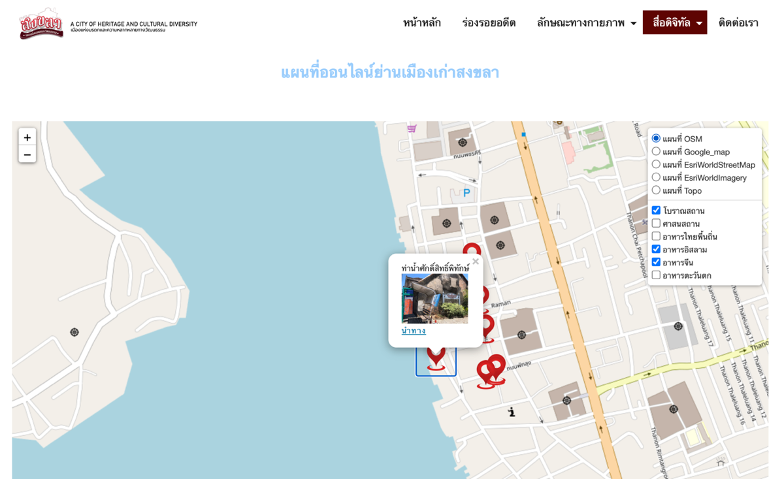Digital Technology for Driving Sustainable Learning in the Old City of Songkhla's Cultural Heritage
Keywords:
Digital Technology, Cultural Heritage, Old City of Songkhla, Sustainable LearningAbstract
The objectives of this study are as follows: 1) to design and implement a spatial database system that features cultural heritage sites; 2) to establish a via the internet mapping system that can be used to exhibit cultural heritage sites; and 3) to construct a prototype automated response system that delivers pertinent information regarding cultural heritage sites situated in the historical city districts of Songkhla, more precisely along Nang Ngam Road, Nakhon Nok Road, and Nakhon Nai Road. As the only criterion for inclusion, architectural, historical, and lifestyle elements are prioritized over geospatial coordinates. Geographic data is gathered during the research process by conducting literature evaluations that focus on the cultural heritage of Songkhla, specifically in the domains of architecture, history, and way of life. In addition to photographs, geographic coordinates of pertinent sites were gathered through fieldwork. The gathered information was classified into two categories: tangible cultural heritage locations, which include landscapes and architecture, and intangible cultural heritage, which includes food, traditions, customs, and beliefs. The data were structured using the WGS1984 datum in conjunction with the UTM grid coordinates. The research has yielded the creation of three systems: an automated response system, an online mapping system, and a geospatial database. The purpose of these platforms is to facilitate the distribution of knowledge regarding the cultural heritage of the ancient city of Songkhla. In order to acquaint community members and pertinent organizations with the online mapping system and the automated response system, instructional and knowledge transfer sessions were organized. User satisfaction with the systems as a whole is very high, according to the study, which reveals an average rating of 4.59 and a standard deviation of 0.54. These systems facilitate the extensive distribution of significant knowledge regarding worldwide cultural heritage, thereby aiding in the conservation of traditional ways of living and promoting a more profound affinity towards the region.
References
กรมศิลปากร. (2563). ระบบภูมิสารสนเทศ แหล่งมรดกทางศิลปวัฒนธรรม. จาก https://gis.finearts.go.th/fineart/.
กฤตธัช วงษ์คำ ศุภรัตน์ พิณสุวรรณ และวรุตม์ นาฑี. (2564). การจัดทำฐานข้อมูลทางภูมิศาสตร์เพื่อพัฒนาเครือข่ายโฮมสเตย์และสถานที่ท่องเที่ยวเชิงภูมิศาสตร์ในอำเภอทุ่งหว้า จังหวัดสตูล. การประชุมวิชาการระดับชาติด้านภูมิศาสตร์และภูมิสารสนเทศศาสตร์ มหาวิทยาลัยในภาคใต้ครั้งที่ 1 วันที่ 17 พฤศจิกายน 2564. สงขลา: คณะมนุษยศาสตร์และสังคมศาสตร์ มหาวิทยาลัยทักษิณ.
จเร สุวรรณชาต. (2560). สงขลาสู่เมืองมรดกโลก. สงขลา: ภาคีคนรักเมืองสงขลาสมาคม.
ชัยวัฒน์ ชินอุปราวัฒน์. (2553). นครสงขลา เมืองเก่าและเรื่องราวในอดีต. อนุสาร อสท. 50(11), 51-61.
ธัญญรัตน์ ไชยคราม. (2563). การประยุกต์เทคโนโลยีภูมิสารสนเทศเพื่อสร้างแผนที่ออนไลน์ผ่านเทคโนโลยี Google Maps GIS Online ในกลุ่มการท่องเที่ยวภาคตะวันออกเฉียงเหนือของประเทศไทย. วารสารวิทยาศาสตร์และเทคโนโลยี. 28(4), 575-586.
ปิยาภรณ์ ธุระกิจจำนง, งามเพชร อัมพรวัฒนพงศ์, ธนวัฒน์ เลขาพันธ์, เจนจิรา ขุนทอง, รอฮานา แวดอเลาะ และทวีสินธุ์ ตั้งเซ่ง. (2562). ศักยภาพทรัพยากรในเขตมรดกทางวัฒนธรรม พื้นที่เมืองเก่าสงขลา เพื่อการพัฒนาการท่องเที่ยวอย่างยั่งยืน. คณะสถาปัตยกรรมศาสตร์ มหาวิทยาลัยเทคโนโลยีราชมงคลศรีวิชัย. สงขลา.
ลักษณา สัมมานิธิ และ สิริวัฒก์ สัมมานิธิ. (2556). การสำรวจศักยภาพและพัฒนาฐานข้อมูลระบบภูมิสารสนเทศเมืองโบราณในแอ่งเชียงใหม่-ลำพูน เพื่อเป็นแนวทางพัฒนาการท่องเที่ยวเชิงพื้นที่อย่างยั่งยืน. คณะสถาปัตยกรรมศาสตร์และการออกแบบสิ่งแวดล้อม มหาวิทยาลัยแม่โจ้. เชียงใหม่.
ลักษนันท์ พลอยวัฒนาวงศ์. (2559). ระบบระบบฐานข้อมูลสารสนเทศมรดกภูมิปัญญาวัฒนธรรมท้องถิ่น จังหวัดสุพรรณบุรี. กรุงเทพฯ: สาขาเทคโนโลยีสารสนเทศ คณะวิทยาศาสตร์และเทคโนโลยี มหาวิทยาลัยเทคโนโลยีราชมงคลสุวรรณภูมิ.
ศูนย์มานุษยวิทยาสิรินธร (องค์การมหาชน). (2567). ย่านเมืองเก่าสงขลา. จาก https://wikicommunity.sac.or.th/community/349.
สำนักงานเทศบาลเมืองลำพูน. (2560). เล่าเรื่องเมืองเก่า. จาก https://lamphuncity.go.th/เล่าเรื่องเมืองเก่า/.
สำนักงานนโยบายและแผนทรัพยากรธรรมชาติและสิ่งแวดล้อม. (2561). รายงานการประชุมสัมมนาวิชาการ คณะอนุกรรมการอนุรักษ์และพัฒนาเมืองเก่า ภายใต้โครงการอนุรักษ์และพัฒนาเมืองเก่า. จาก http://www.onep.go.th/nced/wp-content/uploads/2018/04/proceeding-1.0.pdf.
สำนักงานสภาพัฒนาการเศรษฐกิจและสังคมแห่งชาติ. (2564). แผนยุทธศาสตร์ชาติระยะ 20 ปี (2561-2580). กรุงเทพฯ: สำนักงานเลขานุการของคณะกรรมการยุทธศาสตร์ชาติ.
สุรัตน์ เลิศล้ำ. (2556).การศึกษาความเชื่อมโยงของวัฒนธรรมท้องถิ่นสมัยอดีตถึงปัจจุบันเพื่อพัฒนาฐานข้อมูลวัฒนธรรมและอารยธรรมโบราณในพื้นที่บริเวณลุ่มแม่น้ำโขงและคาบสมุทรมลายา. วารสารวิชาการโรงเรียนนายร้อยพระจุลจอมเกล้าวิทยาศาสตร์และเทคโนโลยี. 11, 109-121.
Likert, R. (1967). The Method of Constructing and Attitude Scale, In Reading in Fishbeic, Martin, Ed, Attitude Theory and Measurement, Wiley & Son, New York, U.S.A., 90-95.





